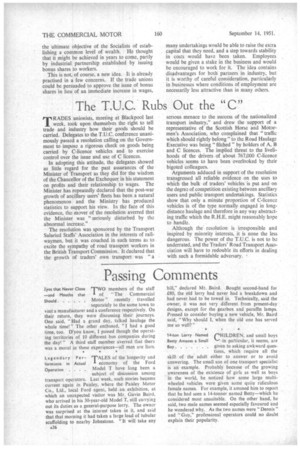'ffie T.U.C. Rubs Out the "C"
Page 28

If you've noticed an error in this article please click here to report it so we can fix it.
TRADES unionists, meeting at Blackpool last week, took upon themselves the right to tell trade and industry how their goods should be carried. Delegates to the T.U.C. conference unanimously passed a resolution calling on the Government to impose a rigorous check on goods being carried by C-licence vehicles and to exercise control over the issue and use of C licences.
In adopting this attitude, the delegates showed as little regard for the past assurances of the Minister of Transport as they did for the wisdom of the Chancellor of the Exchequer in his statement on profits and their relationship to wages. The Minister has repeatedly declared that the post-war growth of ancillary users' fleets has been a natural phenomenon and the Ministry has produced statistics to support his view. In the face of this evidence, the mover of the resolution averred that the Minister was "seriously disturbed by the abnormal increase."
The resolution was sponsored by the Transport Salaried Staffs' Association in the interests of railwaymen, but it was couched in such terms as to excite the sympathy of road transport workers in the British Transport Commission. It declared that the growth of traders' own transport was "a serious menace to the success of the nationalized transport industry," and drew the support of a representative of the Scottish Horse and Motormen's Association, who complained that " traffic which should rightly belong" to the Road Haulage Executive was being " filched " by holders of A, B and C licences. The implied threat to the livelihoods of the drivers of about 767,000 C-licence vehicles seems to have been overlooked by their bigoted colleagues.
Arguments adduced in support of the resolution transgressed all reliable evidence on the uses to which the bulk of traders' vehicles is put and on the degree of competition existing between ancillary users and public transport undertakings. Statistics show that only a minute proportion of C-licence vehicles is of the type normally engaged in longdistance haulage and therefore in any way abstracting traffic which the R.H.E. might reasonably hope to handle.
Although the resolution is irresponsible and inspired by minority interests, it is none the less dangerous. The power of the T.U.C. is not to be underrated, and the Traders' Road Transport Association will have to redouble its efforts in dealing with such a formidable adversary. •




















































































